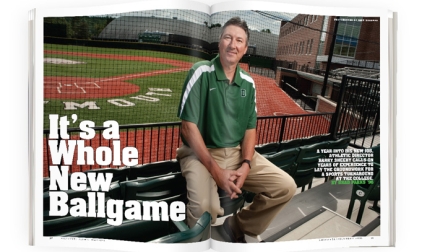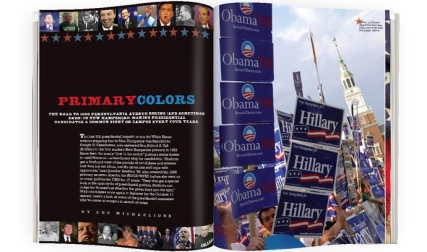Stepping onto the first floor of Bergdorf Goodman, the luxury goods department store on New York City’s Fifth Avenue, it’s hard not to be reminded of one’s relative poverty. Inside, saleswomen in silk scarves loom behind glass counters displaying Prada bags and diamond jewelry by designers such as Lorraine Schwartz and Cindy Chao. When I ask a salesman about the difference between the customers who buy his wares, priced somewhere between a used Hyundai and a new Mercedes, and those who shop in the jewelry department on the fifth floor, he smiles, his tone reminiscent of a minor character in an Oscar Wilde play: “I don’t know who shops on the fifth floor.”
You’ll find Lulu Frost, the line by jewelry designer Lisa Salzer, on Bergdorf’s fifth floor. Known as 5F, it features accessories and apparel for a forward-looking crowd. In contrast to the investment-piece designers downstairs, Salzer has made her name creating what is known as “costume” or “fashion” jewelry, combining antique and modern elements into works intended to be worn as part of a woman’s daily fashion. Assuming, of course, you are the type of woman able to pull off the 100 Year Necklace—a rainbow of ornate design composed of dozens of individual elements dating from each of the decades between 1860 and 1960—or earrings that begin with a pearl then drip, like tiny stalactites, into a porcupine quill.
I meet Salzer, whose slender frame and angular face allow her to serve as a functional model for her creations, in her newly acquired design studio in Manhattan’s Flatiron district. With its 19-foot ceilings, the office seems the platonic ideal of a jewelry designer’s workspace: decorated with antique bottles and oversized books, filled with a dozen stylish and busy employees. Interrupted only by construction workers hoisting themselves in and out of the window, Salzer explains that the historic landmark, which originally housed one of the city’s first Lord & Taylor stores, “embodies our message” of reimagining the old to create something new.
Salzer, who grew up in Syosset on Long Island, learned at a young age that inherent in every piece of jewelry is a potential story. Her grandmother and company namesake, Elizabeth Rock Frost, worked as manager in an estate jewelry store until the age of 92. On holidays Frost gave Salzer and her family pieces of jewelry tailored to their personalities and lives. “I don’t just want something pretty,” Salzer says of her own work, pinching a lion pendant from her grandmother between her fingers. “There has to be something meaningful behind it.”
So although the glass display cases housing Lulu Frost’s collections are the studio’s focal point, its heart lies tucked in the corner, hidden within an 18-drawer letter case—an antique (of course) that originally housed movable type for a printing press. Salzer opens each shelf with the pride of an archaeologist. Inside, arranged by era, lies a collection of thousands of trinkets: Victorian fob chains from the 1870s, marcasite brooches, initial pins, three drawers’ worth of charms and Art Deco bangles made of Bakelite—an early form of plastic—to name only a few. Linda Salzer, Lisa’s mother and Lulu Frost’s primary buyer of these “raw” goods, says her daughter seeks out materials based not on their expense, but on what makes them unique.
These materials will go directly into a piece or serve as inspiration, for Salzer’s gift lies in her ability to see an object not as it was, but rather as it could be. Using the shelves’ contents, Salzer creates and sketches concepts with her design director, Carly Leach, then refines them into individual styles and groupings of jewelry, constructing samples of their work. Salzer and company director Sandra Merrill present the samples to next season’s buyers, both brick-and-mortar stores and websites, and then production director Amy Brown oversees filling their orders. Thus the Victorian cut-steel shoe buckles in the second drawer might reappear as a bracelet at Barneys in Shinjuku, Japan. Dress pins from the 1920s could end up converted into next year’s most elegant earrings.
Jenna Lyons, the creative director and president of J.Crew, praises Salzer’s “ability to juxtapose these old vintage references and make them feel really modern.” Salzer first made a splash when she came across the abandoned numbers that once decorated the doorways of the fabled Plaza Hotel. She didn’t see old hunks of bronze: Salzer constructed a necklace that she describes as being “so individual, so sentimental,” due to the history of the numbers and the meaning each wearer brought to them. The original line sold out almost immediately.
Salzer is not the first to inject meaning into her creations. She draws on the symbolism of the past, particularly the Victorian era, in which pearls represented tears and a ring set with a diamond, emerald, amethyst and ruby stood for “dear.” Author Lesley M.M. Blum, to whose book Let’s Bring Back Salzer contributed two entries (the book’s subtitle, An Encyclopedia of Forgotten-Yet-Delightful, Chic, Useful, Curious and Otherwise Commendable Things from Times Gone By, explains its intent), says, “We’re both concerned with integrating the best of the past and the present.”
That combination of old and new made Dartmouth a logical choice. In many ways Lulu Frost would not have been possible without the College on the Hill. Between hours spent experimenting at the Hopkins Center’s Claflin Jewelry Studio, Salzer and friends would travel to Gemstar Gemstones in Enfield, New Hampshire, for supplies she would fashion into shirts and jewelry to sell to friends. “That’s what gave me the courage to try,” Salzer reflects. “I was sewing up these crazy shirts and people actually bought them.” The Tuck Business Bridge summer program taught the art history major the basics of business; Zach Berke and Chris Lentz ’02 designed her first website; and jewelry designer Tracey Zabar, mother of friend Ben Zabar ’05, served as an early mentor, helping Salzer prepare for her first big break: presenting her line of work to Barneys New York.
Still, it was something of a leap of faith to set out into the world of fashion as Salzer watched her classmates dive into more traditional fields—and their accompanying paychecks. Her parents promised her a year of support to start her company, after which they expected Salzer to follow her siblings into professional graduate schools. “I have to be totally honest that I wasn’t sure she would make it,” Linda Salzer admits. Yet by the end of that first year, during which Salzer supported herself working part-time at her sister’s orthodontist office, Salzer had two employees, positive press and the legitimacy that came with having her work carried in Barneys.
“I know all about the hustle,” Salzer says as we venture on a shopping trip to boutiques in the West Village. Salzer convinced the first such boutique, JuliAna on Hanover’s Main Street, to buy 10 pairs of her earrings by walking into the store with her work and asking its proprietress for a minute of her time. Kathryn Fortunato, co-owner of Lizzie Fortunato Jewels, a successful acces-sories line featured in Elle, says Salzer is “overflowing with energy.” Sandra Merrill, director of Lulu Frost (and Salzer’s best friend), puts it another way: “Lisa has always been a person who, when she is excited about something, it’s kind of contagious.” That enthusiasm has translated to financial success, even in a difficult economy. Since its inception Lulu Frost has experienced continuous annual growth and is well over the $1 million-revenue mark.
Even so, Salzer’s work isn’t for everyone. I conducted a survey that would infuriate statisticians, standing near the Lulu Frost display at Bergdorf and asking browsers for their thoughts. The most common complaints revolved around the price (which generally hovers in the low hundreds) and the “loudness” of certain pieces. “I could never wear that,” a woman named Gina said of a Buffalo Nickel necklace, though she did admit to enjoying a Navette bracelet.
Such criticisms aside, Lulu Frost has been met with accolades from the likes of Vogue and W, an ever-growing list of retailers in the United States and internationally, and celebrity fans including actress Cate Blanchett and musician Florence Welch. “When Jenna Lyons showed me [Salzer’s] collection I thought it was incredibly creative and like nothing I had ever seen,” raves Mickey Drexler, the larger-than-life CEO of J.Crew. Salzer remains humble, however, citing advice her father gave her about not judging her merit based on the opinions of others.
Salzer remains shockingly normal if not charmingly eccentric. We dine on turkey chili for lunch; she drinks water from a Nalgene bottle. And I witness the joy she derives from the half-nude, cross-dressing man we encounter while browsing the Antiques Garage at the Hell’s Kitchen flea market. As Richard Cullen, owner of Archangel Antiques, once told Lisa, “I know you think we’re all crazy, but you’re one of us.”
Salzer’s work, like that of any good artist, is always evolving. In addition to “Color Story,” a collection that launched this fall, Salzer will continue her Lulu Frost for J.Crew line (including bangles Drexler describes as “extraordinary”), expand “Code,” a series of gold and diamond rings inspired by her Plaza collection, and create numerous lines for overseas clients.
Ironically, Salzer’s biggest financial success may come from a line that has nothing to do with the vintage aesthetic that has brought her fame. Braced-lets are bright, rubber bracelets decorated with—yes—orthodontic braces. Salzer designed them in collaboration with her orthodontist sister Jennifer and Jennifer’s partner, Dr. Marc Lemchen.
I was bewildered when she first unveiled Braced-lets to me: Who would want to relive the sore lips and awkward photos of preadolescence? Would decorative acne be next? I was wrong. My girlfriend wore Braced-lets to dinner and practically had to fend off the actress and television writer who joined us from yanking them off her wrist. I then noticed the glowing coverage Braced-lets were receiving in The New York Times and Harper’s Bazaar and the rapidity with which they were disappearing from the shelves of trendy stores. Karen Meena, vice president of merchandising and buying for RonRobinson at Fred Segal in Los Angeles, wore a wrist full of Braced-lets (which she often pairs with her Cartier bracelet) when we spoke. She credits Lisa’s “vision and creativity” for Braced-lets’ success, adding, “She’s just a trendsetter.”
Retailing at $5 each and looking best when stacked on the wrist, it’s not hard to imagine Braced-lets representing a windfall for Salzer and her partners. They’ve moved more than 100,000 units in about two months and anticipate selling more than a million in their first year. To keep momentum building, Salzer plans to introduce a coding system to Braced-lets (echoing, of course, the Victorians) to allow customers pre- and post-adolescent to send each other hidden messages.
“This is going to be far and away bigger than Lulu Frost, which is hilarious,” Salzer says, admitting that she “probably sported those [orthodontic] torture devices for too long” as child. In typical fashion, where the rest of us might have stopped at teenage hell, Salzer sees something beautiful.
Alexis C. Jolly lives in Los Angeles. He wrote “A Devil’s Dictionary” in the July/August issue of DAM.




